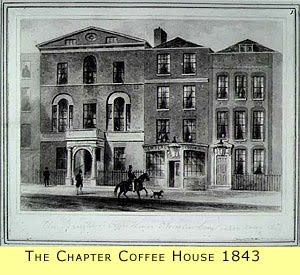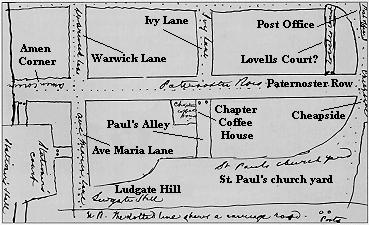I’ve been visiting London again this week, and as always I stayed in Bankside on the south shore of the River Thames. It’s a great location, walked by the likes of Shakespeare, Dickens, Chaucer and many others – and across the Thames via the Millennium Bridge lies the majestic St. Paul’s Cathedral designed by Sir Christopher Wren.

It’s been a breathtaking sight for over four centuries now, and whilst I stay across the river from it, the Brontë sisters stayed in the very shadow of St. Paul’s, as I hope to show in today’s post. The London location favoured by the Brontës was the Chapter Coffee House.
By the time the Brontës stayed in the coffee house (which also served as a guest house) it already had a fine literary reputation as it had served as a late eighteenth century meeting point for writers like Oliver Goldsmith, Samuel Johnson and Thomas Chatterton. There’s a more likely reason why it became the London residence of the Brontës however: its proximity to St. Paul’s.
The streets around this area show its ecclesiastical influence, with names such as Amen Corner and Ave Maria Lane. It is likely that the Chapter Coffee House was in extensive use by members of the clergy visiting St. Paul’s and that this was how it came to the attention of Reverend Patrick Brontë. Patrick visited it in 1842, with his daughters Charlotte and Emily Brontë, a year before this picture of the house was made:

At this time Patrick was accompanying his daughters en route to them entering school in Brussels. He helpfully drew a map of the area, and marked the location of the Chapter Coffee House upon it:

Charlotte returned to London in 1848, and this time it was her youngest sister Anne Brontë with her. They had journeyed to the capital in some haste after receiving a letter implying that the Bell brothers (Currer, Ellis and Acton) were one and the same person. So rapidly did they travel that they had given no thought to where they might stay when they arrived in London in the early hours of a Saturday morning. Charlotte later recalled how they ordered a horse drawn cab to take them and their luggage to the Chapter Coffee House simply because it was the only place in London she knew.
But just where is, or was, the Chapter Coffee House? It’s not there now, but the area around St. Paul’s was badly damaged during the Ritz and I believe that the Chapter Coffee House burned down during the war. I also believe that we can still see where the house once stood, and explain why in this video I made:
A transcript of the video follows here: “I’m here in St Paul’s Churchyard in search of the location of the Chapter Coffee House. The Chapter Coffee House was destroyed by fire during World War II. It’s here that Charlotte and Anne Brontë stayed in London in 1848 in a few days that changed literary history forever. So behind me is St Paul’s Cathedral and in this direction is Ave Maria Lane. Behind me is St Paul’s Alley. These were all marked on Patrick Brontë’s map and behind me through there is Paternoster Row where the Chapter Coffee House was.
Now this gap behind me was caused by the destruction during the blitz of World War II. I believe this is the very spot where the Chapter Coffee House stood and where Charlotte and Anne Brontë stayed. And now right next to it we have a coffee house, Paul’s Coffee House. I believe this is the Brontë’s home in London.”
After posting this on my Twitter account (where I tweet daily about the Brontes) I received some validation from the staff of St. Paul’s Cathedral itself:

When we walk in the shadow of St. Paul’s we walk in the footsteps of Charlotte, Emily and ANne Brontë, and I recommend it to anyone who visits London. I’m back in Yorkshire now, and hope you can join me next Sunday for another new Brontë blog post.
